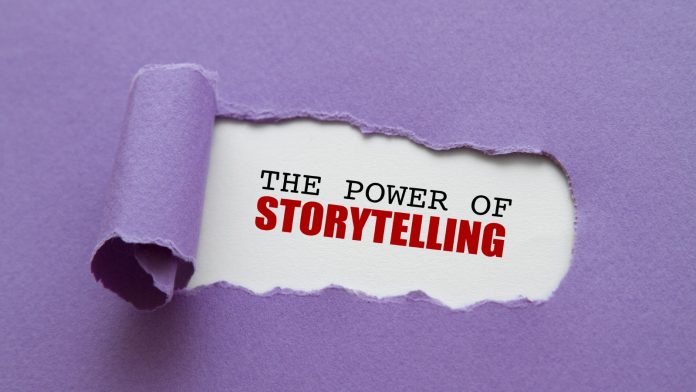“You can have a perfect website structure, SEO-optimized headlines, and flawless design.
But if your words don’t carry soul, no one will stay. No one will care.”
Every brand has a logo.
Every service has a price.
Every website has a navigation bar.
But not every brand has a voice.
Not every offer has a story.
And not every business leaves a memory.
In a world flooded with content, the brands that stand out are not the ones that say the most —
but the ones that say what matters.
What Story Actually Is — and Isn’t
Let’s clear something up:
Story isn’t decoration. It’s not fluff or filler.
It’s not “once upon a time” copywriting for dreamers.
It’s not poetry pretending to sell.
Story is structure.
Story is strategy.
It is the spine of meaning behind everything your brand says, writes, or publishes.
When used right, story:
- Builds emotional connection
- Creates clarity around your purpose
- Makes you memorable — and trustworthy
- Guides your customer’s journey like a map
Think of story not as art — but as architecture.
Structure Tells Them Where to Go.
Story Tells Them Why to Stay.
You can have the cleanest website on the internet.
You can follow every UI/UX best practice.
You can nail mobile responsiveness, loading speed, and scroll flow.
But if the words on your homepage don’t resonate, you’re building a cathedral of silence.
Your structure may invite them in —
but your story is what makes them want to stay.
And in business, staying leads to trusting.
Trusting leads to buying.
Why Emotion Converts
We often think customers are rational.
But emotion drives 95% of decision-making. Logic just justifies it afterward.
When you infuse your brand’s copy — your homepage, your product descriptions, your about page — with emotional truth, you unlock a deeper layer of connection.
- You stop “pitching.”
- You start relating.
- You stop sounding like everyone else.
- You start sounding like someone real.
People don’t want more information.
They want to feel something.
They want to feel you.
What Happens Without Story?
You get:
- Websites that are “fine” but forgettable
- About pages that sound like CVs
- Tour descriptions that list locations but say nothing
- Author bios that feel like LinkedIn, not literature
- Sales pages that perform… okay
Your content becomes content — instead of a conversation.
Real Examples:
Let’s say you run a travel agency.
Without Story:
“Join our 7-day Croatia tour with luxury hotels, guided excursions, and local cuisine.”
Okay.
But why should I care?
With Story:
“For seven days, walk the same cobbled paths where emperors ruled, poets wandered, and the sea told stories of ships long gone. Stay in family-run villas where tradition meets comfort. Eat meals prepared from recipes older than the maps that guided your journey. This is not a tour. It’s a tale. And you’re part of it.”
Now it’s not about what you’re selling.
It’s about what they’ll feel.
This Applies to Authors Too
If you’re a writer launching a book, story should not just be inside your book.
It should be in how you present it.
Don’t describe your book.
Position it.
Make your blurb a hook, not a summary.
Bad blurb:
“This is a novel about two brothers dealing with war and trauma in a Balkan town.”
Strong, story-infused blurb:
“In a town cracked open by war, two brothers take opposite paths — one toward duty, the other toward darkness. But as the ruins around them deepen, so do the choices they can’t take back. This isn’t a story of war. It’s a story of what war leaves behind.”
Same book.
Different power.
The Elements of Story-Driven Content
If you want to bring soul into your copy — use these tools:
1. Voice
Your brand should sound like a person, not a policy document.
Find your tone: Warm? Witty? Soulful? Fierce? Calm?
2. Conflict
Great stories have tension. So does great copy.
What problem are you solving? What’s at stake for your customer?
3. Transformation
What changes after working with you, visiting your place, reading your book?
Show the journey.
4. Imagery & Metaphor
These are not fluff — they’re memory triggers.
They help abstract concepts feel tactile, real.
Who Needs This Most?
If you’re:
- A travel company selling cultural or luxury experiences
- A tour guide who wants to stand out from “informative” competitors
- A spiritual brand or coach wanting to connect more deeply
- An author needing blurbs, bios, and personal branding
- A business built on passion and meaning, not just product
Then your brand needs story as much as it needs structure.
Final Thought
Structure will help your visitors find your website.
Story will help them find themselves in your message.
And when they do —
they won’t just become clients.
They’ll become believers.
They’ll come back.
And they’ll bring others with them.
Because people forget bullet points.
But they don’t forget how your words made them feel.
Ready to bring story to your brand?
Let’s craft something that sounds, sells, and stays with your audience.

